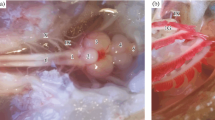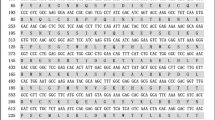Abstract
Hypoxia is among the most critical environmental stressors for fish in aquatic environments, and several energetic alterations have been associated with it. The aim of the present study was to evaluate the involvement of the phosphoryl transfer network and its effects on adenosine triphosphate (ATP)-dependent enzymes during hypoxia, as well as the role of oxidative stress in the activity of the phosphoryl transfer network in pacamã (Lophiosilurus alexandri) subjected to severe hypoxia. Branchial creatine kinase (CK; cytosolic and mitochondrial fractions), adenylate kinase (AK), and pyruvate kinase (PK) activities were inhibited after 72 h of exposure to hypoxia compared to their respective normoxia groups, and remained low (except for AK) after 24 and 72 h of re-oxygenation. Activities of the branchial sodium-potassium pump (Na+, K+-ATPase) and proton pump (H+-ATPase) were inhibited in fish exposed to 72 h of hypoxia compared to the normoxia group, remained inhibited after 24 h of re-oxygenation, and were restored to physiological levels after 72 h of re-oxygenation. Levels of branchial reactive oxygen species (ROS) were higher in fish exposed to hypoxia for 72 h compared to the normoxia group, and increased during re-oxygenation. Lipid peroxidation (LOOH) levels were higher in fish subjected to 72 h of hypoxia compared to the normoxia group, and remained higher during re-oxygenation. On the other hand, protein sulfhydryl (PSH) levels were lower in fish exposed to hypoxia for 72 h compared to the normoxia group, and remained low during re-oxygenation. Based on this evidence, inhibition of the activities of enzymes belonging to phosphoryl transfer network contributed to impairing energetic homeostasis linked to ATP production and ATP utilization in gills of pacamã subjected to hypoxia, and remained inhibited during re-oxygenation (except AK activity). Moreover, inhibition of the phosphoryl transfer network impaired activity of ATP-dependent enzymes, which can be mediated by ROS overproduction, lipid peroxidation, and oxidation of SH groups.




Similar content being viewed by others
References
Ackerly KL, Krahe R, Sanford CP, Chapman LJ (2018) Effects of hypoxia on swimming and sensing in a weakly electric fish. J Exp Biol 221:e172130
Baldissera MD, Souza CF, Petrolli TG, Baldisserotto B, Da Silva AS (2019) Caffeine prevents hypoxia-induced dysfunction on branchial bioenergetics of Nile tilapia through phosphoryl transfer network. Aquaculture 502:1–7
Carrasco AJ, Dzeja PP, Alekseev AE, Pucar D, Zingman LV, Abraham MR, Hodgson D, Bienengraeber M, Puceat M, Janssen E, Wieringa B, Terzic A (2001) Adenylate kinase phosphotransfer communicates cellular energetic signals to ATP-sensitive potassium channels. PNAS 98:7623–7628
Dzeja P, Terzic A (2009) Adenylate kinase and AMP signaling networks: metabolic monitoring, signal communication and body energy sensing. Int J Mol Sci 10:1729–1772
Dzeja PP, Vitkevicius KT, Redfield MM, Burnett JC, Terzic A (1999) Adenylate kinase-catalyzed phosphotransfer in the myocardium: increased contribution in heart failure. Circ Res 84:1137–1143
El-Khaldi ATF (2010) Effect of different stress factors on some physiological parameters of Nile tilapia (Oreochromis niloticus). Saudi J Biol Sci 17:241–246
Fortuoso BF, Baldissera MD, Souza CF, Griss LG, Casagrande RA, de Cristo TG, Santiani F, da Cunha MG, Boiago MM, Stefani LM, Da Silva AS (2019) Impairment of the phosphotransfer network and performance in broiler chickens experimentally infected by Eimeria spp.: the role of the oxidative stress. Parasitol Int 70:16–22
Gemelli T, de Andrade RB, Rojas DB, Zanatta A, Schirmbeck GH, Funchal C, Wajner M, Dutra-Filho CS, Wannmacher CMD (2018) Chronic exposure to β-alanine generates oxidative stress and alters energy metabolism in cerebral cortex and cerebellum of Wistar rats. Mol Neurobiol 55:5101–5110
Gibbs A, Somero GN (1989) Pressure adaptation of Na+-K+-ATPase in gills of marine teleosts. J Exp Biol 143:475–492
Gilmore KL, Doubleday ZA, Gillanders BM (2018) Testing hypoxia: physiological effects of long-term exposure in two freshwater fishes. Oecologia 186:37–47
Grings M, Parmeggiani B, Moura AP, de Moura Alvercem L, Wyse ATS, Wajner M, Leipnitz G (2018) Evidence that thiosulfate inhibits creatine kinase activity in rat striatum via thiol group oxidation. Neurotox Res 34:693–705
Hughes BP (1962) A method for estimation of serum creatine kinase and its use in comparing creatine kinase and aldolase activity in normal and pathological sera. Clin Chim Acta 7:597–603
Hvas M, Oppedal F (2019) Physiological responses of farmed Atlantic salmon and two cohabitant species of cleaner fish to progressive hypoxia. Aquaculture 512:734353
Janssen E, Dzeja PP, Oerlemans F, Simonetti AW, Heerschap A, de Haan A, Rush PS, Terjung RR, Wieringa B, Terzic A (2000) Adenylate kinase 1 gene deletion disrupts muscle energetic economy despite metabolic rearrangement. EMBO J 19:6371–6381
Johannsson OE, Giacomin M, Sadauskas-Henrique H, Campos DF, Braz-Mota S, Heinrichs-Caldas WD, Baptista R, Wood CM, Almeida-Val VMF, Val AL (2018) Does hypoxia or different rates of re-oxygenation after hypoxia induce an oxidative stress response in Cyphocharax abramoides (Kner 1858), a characid fish of the Rio Negro? Comp Biochem Physiol A Mol Integr Physiol 224:53–67
Katoh F, Hyodo S, Kaneko T (2003) Vacuolar-type proton pump in the basolateral plasma membrane energizes ion uptake in branchial mitochondria-rich cells of killifish Fundulus heteroclitus, adapted to a low ion environment. J Exp Biol 206:793–803
Konorev EA, Hogg N, Kalyanaraman B (1998) Rapid and irreversible inhibition of creatine kinase by peroxynitrite. FEBS Lett 427:171–174
LeBel CP, Ischiropoulos H, Bondy SC (1992) Evaluation of the probe 2′,7′-dichlorofluorescin as an indicator of reactive oxygen species formation and oxidative stress. Chem Res Toxicol 5:227–231
Leong SF, Lai JC, Lim L, Clark JB (1981) Energy-metabolizing enzymes in brain regions of adult and aging rats. J Neurochem 37:1548–1556
Li M, Wang X, Qi C, Li E, Du Z, Qin JG, Chen L (2018) Metabolic response of Nile tilapia (Oreochromis niloticus) to acute and chronic hypoxia stress. Aquaculture 495:187–195
Liang F, Li L, Zhang G, Yin S, Wang X, Li P, Jia Y, Wang Y, Wang Y, Wang L, Wang X (2017) Na+/K+-ATPase response to salinity change and its correlation with FXYD11 expression in Anguilla marmorata. J Comp Physiol B 187:973–984
Lin LY, Chiang CC, Gong HY, Cheng CY, Hwang PP, Weng CF (2003) Cellular distributions of creatine kinase in branchia of euryhaline tilapia (Oreochromis niloticus). Am J Phys Cell Physiol 284:233–241
Lowry OH, Rosebrough NJ, Farr AL, Randall RJ (1951) Protein measurement with the Folin phenol reagent. J Biol Chem 193:265–275
Lundgreen K, Kiilerich P, Tipsmark CK, Madsen SS, Jensen FB (2008) Physiological response in the European flounder (Platichthys flesus) to variable salinity and oxygen conditions. J Comp Physiol B 178:909–915
Mahfouz ME, Hegazi MM, El-Magd MA, Kasem EA (2015) Metabolic and molecular responses in Nile tilapia, Oreochromis niloticus during short and prolonged hypoxia. Mar Freshw Behav Physiol 48:319–340
Maltez LC, Barbas LAL, Nitz LF, Pellegrin L, Okamoto MH, Sampaio LA, Monserrat JM, Garcia L (2018) Oxidative stress and antioxidant responses in juvenile Brazilian flounder Paralichthys orbignyanus exposed to sublethal levels of nitrite. Fish Physiol Biochem 44:1349–1362
Mattioli CC, Takata R, Leme FOP, Costa DC, Filho RM, Silva WS, Luz RK (2017) The effects of acute and chronic exposure to water salinity on juveniles of the carnivorous freshwater catfish Lophiosilurus alexandri. Aquaculture 481:255–266
McGarry T, Biniecka M, Veale DJ, Fearon U (2018) Hypoxia, oxidative stress and inflammation. Free Radic Biol Med 125:15–24
Monserrat JM, Geracitano LA, Pinho GLL, Vinagre TM, Faleiros M, Alciati JC, Bianchini A (2003) Determination of lipid peroxides in invertebrates using the Fe (III) xylenol orange complex formation. Arch Environ Contam Toxicol 45:177–183
Neumann D, Schlattner U, Wallimann T (2003) A molecular approach to the concerted action of kinases involved in energy homeostasis. Biochem Soc Trans 31:169–174
Peter MCS, Simi S (2017) Hypoxia stress modifies Na+/K+-ATPase, H+/K+-ATPase, Na+/NH+4−ATPase, and nkaα1 isoform expression in the brain of immune-challenged air-breathing fish. J Exp Neurosci 11:1–18
Pucar D, Janssen E, Dzeja PP, Juranic N, Macura S, Wieringa B, Terzic A (2000) Compromised energetics in the adenylate kinase AK1 gene knockout heart under metabolic stress. J Biol Chem 275:41424–41429
Richards JG (2011) Physiological, behavioral and biochemical adaptations of intertidal fishes to hypoxia. J Exp Biol 214:191–199
Robertson CE, Wright PA, Köblitz L, Bernier NJ (2014) Hypoxia-inducible factor-1 mediates adaptive developmental plasticity of hypoxia tolerance in zebrafish, Danio rerio. Proc Biol Sci 281:20140637
Schlattner U, Klaus A, Rios SR, Guzun R, Kay L, Tokarska-Schlattner M (2016) Cellular compartmentation of energy metabolism: creatine kinase microcompartments and recruitment of β-type creatine kinase to specific subcellular sites. Amino Acids 48:1751–1774
Schlattner U, Kay L, Tokarska-Schlattner M (2018) Mitochondrial proteolipid complexes of creatine kinase. Subcell Biochem 87:365–408
Sedlak J, Lindsay RH (1968) Estimation of total, protein-bound, and nonprotein sulfhydryl groups in tissue with Ellman’s reagent. Anal Biochem 25:192–205
Souza CF, Salbego J, Gressler LT, Golombieski JI, Ferst JG, Cunha MA, Heinzmann BM, Caron BO, Glanzner WG, Gonçalves PBD, Baldisserotto B (2015) Rhamdia quelen (Quoy & Gaimard, 1824), submitted to a stressful condition: effect of dietary addition of the essential oil of Lippia alba on metabolism, osmoregulation and endocrinology. Neotrop Ichthyol 13:707–714
Souza CF, Baldissera MD, Bianchini AE, da Silva EG, Mourão RHV, da Silva LVF, Schmidt D, Heinzmann BM, Baldisserotto B (2018) Citral and linalool chemotypes of Lippia alba essential oil as anesthetics for fish: a detailed physiological analysis of side effects during anesthetic recovery in silver catfish (Rhamdia quelen). Fish Physiol Biochem 44:21–34
Wang H, Chu W, Das SK, Ren Q, Hasstedt SJ, Elbein SC (2002) Liver pyruvate kinase polymorphisms are associated with type 2 diabetes in northern European Caucasians. Diabetes 51:2861–2865
Waskova-Arnostova P, Kasparova D, Elsnicova B, Novotny J, Neckar J, Kolar F, Zurmanova J (2014) Chronic hypoxia enhances expression and activity of mitochondrial creatine kinase and hexokinase in the rat ventricular myocardium. Cell Physiol Biochem 33:310–320
Weng CF, Chiang CC, Gong HY, Chen MHC, Lin CF, Huang WT, Cheng CY, Hwang PP, Wu JL (2002) Acute changes in gill Na+-K+-ATPase and creatine kinase in response to salinity changes in the euryhaline teleost, tilapia (Oreochromis niloticus). Physiol Biochem Zool 75:29–36
Wilson DF, Matschinsky FM (2018) Metabolic homeostasis: oxidative phosphorylation and the metabolic requirements of higher plants and animals. J Appl Physiol 125:1183–1192
Wolosker H, Panizzutti R, Englender S (1996) Inhibition of creatine kinase by S-nitrosogluthathione. FEBS Lett 392:274–276
Yang S, Tan T, Wu H, Xiao Q, Fu HM, Luo J, Zhou J, Zhao LL, Wang S, Yang SY, Sun JL, Ye X, Li SJ (2017) Acute hypoxic stress: effect on blood parameters, antioxidant enzymes, and expression of HIF-1alpha and GLUT-1 genes in largemouth bass (Micropterus salmoides). Fish Shellfish Immunol 67:449–458
Zeng L, Wang YH, Ai CX, Zheng JL, Wu CW, Cai R. (2016) Effects of β-glucan on ROS production and energy metabolism in yellow croaker (Pseudosciaena crocea) under acute hypoxic stress. Fish Physiology and Biochemistry 42, 1395–1405
Zervou S, Whittington HJ, Ostrowski PJ, Cao F, Tyler J, Lake HA, Neubauer S, Lygate CA (2017) Increasing creatine kinase activity protects against hypoxia/reoxygenation injury but not against anthracycline toxicity in vitro. PLoS One 12:0182994
Acknowledgments
R.K. Luz and B. Baldisserotto received Conselho Nacional de Desenvolvimento Científico e Tecnológico (CNPq, Brazil) research fellowships; M. D. Baldissera received a CNPq post-doctorate fellowship; and C.F. Souza received a CAPES, Brazil (Coordenação de Aperfeiçoamento de Pessoal de Nível Superior) post-doctorate fellowship (Finance Code 001).
Author information
Authors and Affiliations
Corresponding authors
Additional information
Publisher’s note
Springer Nature remains neutral with regard to jurisdictional claims in published maps and institutional affiliations.
Rights and permissions
About this article
Cite this article
Baldissera, M.D., de Freitas Souza, C., Boaventura, T.P. et al. Involvement of the phosphoryl transfer network in gill bioenergetic imbalance of pacamã (Lophiosilurus alexandri) subjected to hypoxia: notable participation of creatine kinase. Fish Physiol Biochem 46, 405–416 (2020). https://doi.org/10.1007/s10695-019-00728-0
Received:
Accepted:
Published:
Issue Date:
DOI: https://doi.org/10.1007/s10695-019-00728-0




